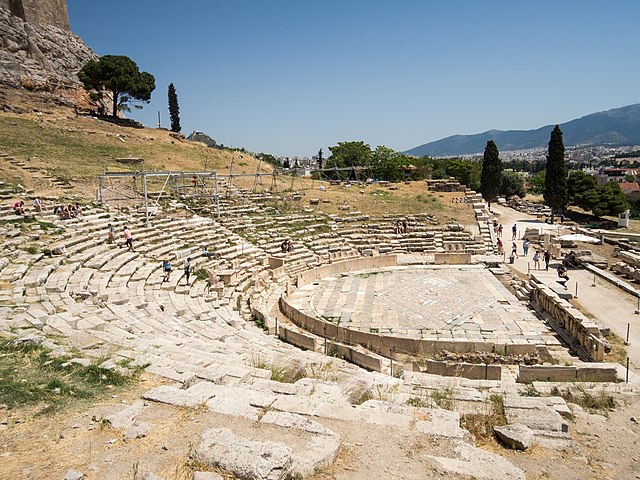In the theatre of ancient Greece, the choregos was a wealthy Athenian citizen who assumed the public duty, or choregiai, of financing the preparation for the chorus and other aspects of dramatic production that were not paid for by the government of the polis or city-state. Modern Anglicized forms of the word include choragus and choregus, with the accepted plurals being the Latin forms choregi and choragi. In Modern Greek, the word χορηγός is synonymous with the word "grantor".
Relief of seated Dionysus and satyr; inscription beneath is a decree by the deme Aixone honoring the choregoi Auteas and Philoxenides (313–312 BC)
Choragic Monument of Lysicrates near the Acropolis in Athens, Greece
Theatre of ancient Greece
A theatrical culture flourished in ancient Greece from 700 BC. At its centre was the city-state of Athens, which became a significant cultural, political, and religious place during this period, and the theatre was institutionalised there as part of a festival called the Dionysia, which honoured the god Dionysus. Tragedy, comedy, and the satyr play were the three dramatic genres emerged there. Athens exported the festival to its numerous colonies. Modern Western theatre comes, in large measure, from the theatre of ancient Greece, from which it borrows technical terminology, classification into genres, and many of its themes, stock characters, and plot elements.
Bronze statue of a Greek actor, 150–100 BC. The half-mask over the eyes and nose identifies the figure as an actor. He wears a man's conical cap but female garments, following the Greek custom of men playing the roles of women. Later, slave women were brought in to play minor female characters and in comedy as well.
View of the ancient theatre at Epidaurus, considered by Pausanias the finest in Greece.
The Theatre of Dionysus
Roman, Republican or Early Imperial Relief of a seated poet (Menander) with masks of New Comedy, 1st century BC. – early 1st century AD, Princeton University Art Museum






